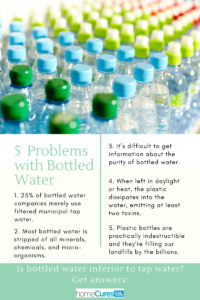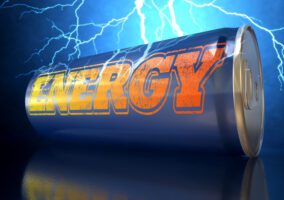The Drinking Water Dilemma
As an avid hiker and backpacker, one of the joys I experience in the wilderness is finding a cold, clear stream or river to serve as a source of water for drinking and cooking. In former days (before we knew better) I’d simply dip a tin cup into that cool, clear water and quench my thirst, but now I use a simple filter.
Next to the air we breathe, water is the most vital ingredient for life. Our bodies contain more water than any other substance. And water is the most abundant substance on earth. Centuries ago, Leonardo da Vinci recognized this when he said, “Water is the driving force of all nature.”
Every molecule of water consists of two atoms of hydrogen and one atom of oxygen (H2O). One of water’s most amazing properties is its ability as a “universal solvent.” There are relatively few substances that water can’t dissolve.
It’s precisely this property of water that we want to focus on, because water’s ability as a solvent also means that it’s rarely pure.
Water Purity
Nearly 1 billion people in developing countries do not have access to safe water.[1] For instance, in recent years, many US churches, (like Southside Christian Church in Spokane, WA) and other non-profits (like TheWaterProject.org) have been drilling wells in parts of rural Africa where people formerly travelled miles each day to fetch water from contaminated sources. Now these people have access to clean water in their own villages.
Natural disasters like hurricanes and earthquakes and man-made disasters like chemical spills and wars also jeopardize clean drinking water.
But what about our municipal drinking water? Is our tap water safe? Dozens of companies are offering bottled water, but can we trust those sources as “pure”? And how about all the water filtration systems?
Ironically, in America, we seem to have a fetish about water purity, yet most of us would have to admit that we don’t drink enough of life’s elixir. We take the availability of fresh water for granted and have lots of options.
But what do we mean by “purity”? If by “purity” we mean H2O and nothing else, we’ll probably be disappointed, because many of the minerals often found in drinking water are not only good for us, but make the water taste better. Some of the good minerals include: calcium, magnesium and potassium. In fact, you may have noticed the labels on some bottled waters say something like, “Minerals added for flavor.”
On the flip side, water may also contain bad minerals and chemicals like: lead, arsenic, antimony, sulfur, sodium chloride, aluminum, barium, chlorine and nitrates.
In the 60s, my family traveled each summer to a small town in southwest Missouri for a family reunion. The city water in that town had high concentrations of sulfur in it—so high in fact that you could smell the sulfur coming out of the tap! And all the faucets and pipe joints were encrusted with thick, white mineral deposits. (Note that was before the Safe Drinking Water Act was instituted.)
Then, in the 90s, we lived in north-central Texas. Especially during the summer months, the tap water there tasted like highly chlorinated lake water, fishy flavor and all! The chlorine content was so high in that tap water that the chlorine gas emitted during a hot shower made your eyes and throat burn!
But even the water bubbling out of a remote mountain spring or trickling off a glacier is loaded with organic and inorganic material. Even in its natural state, no water is pure. So, where does that leave our tap water?
Tap Water
According to the Environmental Protection Agency’s (EPA) own site: “The United States enjoys one of the world’s most reliable and safest supplies of drinking water. Congress passed the Safe Drinking Water Act (SDWA) in 1974 to protect public health, including by regulating public water systems.”[2]
Filtration systems used by municipalities to ensure they’re providing clean water are highly regulated by the EPA. Any chemicals, like chlorine, are added to rid the water of any micro-organisms that could be harmful.
The relative purity of municipal drinking water varies from region to region. For instance, a friend of mine lives in Florida. She consulted the Environmental Working Group (EWG) regarding the purity of their municipal drinking water and discovered that it contains four contaminants above “health guidelines” and the presence of 10 other unwanted contaminants.[3]
You can request a Consumer Confidence Report from your local municipality, or go to the EPA: www.epa.gov/safewater/dwinfo/index.html to find out what contaminants are in your drinking water. You can also check out the EWG database on drinking water contamination at https://www.ewg.org/tapwater/#.Wn9AUbpFzIV.
Jane Houlihan, VP of Research for the EWG explains about the purity of tap water: “It matters a lot where you live. Someone who lives in Washington, D.C., at the outlet of a major river that collects pollution from different states upstream is drinking a cocktail of pollutants, and not all of them are removed at the treatment plant.”[4]
According to research compiled in the 2006 United States Drinking Water Quality Study Report, if you’re lucky enough to live in Des Moines, IA, Austin, TX, or Sioux Falls, SD you can enjoy some of the safest drinking water in the nation. For this reason, Houlihan urges citizens to read the annual report that their water supplier provides.[5]
Also, having a private well by no means promises purity. Private wells may even be more susceptible to contamination than public utilities, because there’s less oversight.
Chlorine
Chlorine has been used in the treatment of drinking water in the US since 1904. The positive side of chlorine is that it kills microorganisms that cause deadly diseases like cholera and salmonella. Chlorine is largely to thank why the US has one of the safest water supplies in the world.[6]
But there are some significant downsides to the use of chlorine as well. First, it does not guarantee elimination of all microorganisms. Both e-coli and coliform can survive in chlorinated water. Perhaps even more disturbing is that “when chlorine is added to water, it forms Trihalomethanes (THMs), one of which is chloroform. THMs increase the production of free radicals in the body and are highly carcinogenic (cancer-causing).”[7]
Thus, according to the US Council of Environmental Quality, “Cancer risk among people using chlorinated water is as much as 93 percent higher than among those whose water does not contain chlorine.” And bathing in it can be as harmful as drinking it.[8]
Lastly, chlorine makes water taste—well, like chlorine!
Bottled Water
In recent years, there’s been growing mistrust of the safety of drinking tap water. This mistrust is perhaps due to both the strong marketing tactics of bottled water suppliers and our increased awareness of the contaminants in municipal water, including chlorine. For this reason many are skeptical of the safety of drinking tap water.
As a result, millions of Americans have turned to bottled water as their source of drinking water. But how safe is bottled water? Where does that water come from?
Interestingly, “The consensus between the two primary water quality regulating groups [EPA and EWG] and health research is that bottled water is inferior in quality to tap water.”[9] There appear to be numerous problems with bottled water:
- About 25% of bottled water companies merely use filtered municipal tap water and resell it to you at high prices. These include brands like Aquafina, Nestle and Dasani.[10]
- Most bottled water goes through an extreme filtration process that strips the water of all minerals, chemicals, and micro-organisms. While on the surface this sounds good, what it yields is termed “dead water.”[11] Dead water contains none of the good minerals that are healthy for our bodies. In fact, there’s evidence that when we drink water stripped of all minerals, that water will seek to bond with minerals in our bodies, leaching them from our bones and organs.
- While it is easy to obtain information about the purity of your tap water, it’s a lot more difficult to get information about the purity of bottled water.[12] In fact, studies have revealed bottled water containing: phthalates, mold, microbes, benzene, trihalomethanes, arsenic, coliform, and other carcinogens.[13] The reason for this is that there is far less oversight of bottled water than of municipal water. In a study conducted by the World Wildlife Fund International, they concluded that “bottled water may be no safer or healthier than tap water, while selling for up to 1,000 times the price.”[14]
- Most bottled water comes in plastic bottles. When left in daylight or especially in heat, the plastic dissipates into the water, emitting at least two toxins: Bisphenol A (BPA) and Dioxin.[15], [16] No doubt you’ve tasted the plastic in bottled water at times. The chemicals used in plastic are not healthy or meant to be ingested. For one thing, we know that plastic disrupts our endocrine system, which can lead to problems with our hormones, lead to infertility, and cause cancer.[17]
- Another problem with those plastic bottles is how to dispose of them. They’re practically indestructible and they’re filling our landfills by the billions.
Many people claim they like the taste of bottled water over other sources. But in a blind taste test, Good Morning America’s studio audience picked tap water over bottled water for best taste. In fact, the tap water that took the most votes for taste was New York City’s tap water.[18]
Home Filtration Systems
Given the above issues with both tap water and bottled water, a home filtration system may be your best option for safe, pure drinking water.
There are too many types and makes of filtration systems to do this subject justice in this article. But suffice it to say that if you want a home filtration system, choose one that removes the chlorine and any other unwanted chemicals and micro-organisms from your water.
Four Recommended Water Filters for Removing Chlorine:[19]
- Reverse osmosis, under-the-sink filters – iSpring RCC7
- Whole house system – Aquasana Rhino EQ-400
- The water filter pitcher – ZeroWater 10 Cup Pitcher
- Shower chlorine filter – Culligan WSH-C125
Distillation is NOT a good filtration method for drinking water as it robs your water of all minerals and leaches minerals from your body.[20]
Drink Water for Your Health
Pure water is the world’s first and foremost medicine. – Slovakian proverb
Doctors continue to urge us to drink about 8 glasses of water per day. The amount of water you actually need varies depending on your age, the climate where you live, your level of activity, and your body mass. Also, it’s okay to get some of your water through other sources like coffee, tea and juice. But drink mostly water.
Here are some other health benefits of drinking plenty of water:[21]
- Helps you lose weight – Feeling hungry? Drink a glass of water instead of eating that snack.
- Boosts your energy – If you’re energy is draining, you may need to hydrate.
- Lowers your stress – Dehydration places stress on your brain and body.
- Builds muscle tone and prevents cramping – Muscles consist primarily of water, so replenish it especially during workouts.
- Nourishes your skin – Skin too is mostly water. Drinking water also removes impurities and improves circulation.
- Improves digestion – If your urine is dark or yellow, it’s a good indication that you’re not drinking enough water.
- Reduces the threat of kidney stones – Water dissolves the minerals in your body that form kidney stones.
Well, there you have it. Our bodies need and even crave water.
In fact, just writing this article has made me thirsty and reminded me how important it is to drink more of this life-giving elixir. I hope you’ll do the same. Here’s to your health!
Could mega-happiness, self-love, and flashes of brilliant insight be just a glass of water away? Keep reading for a super-simple recipe to make your water even more refreshing. Take your hydration to the next level with this simple hack.

























